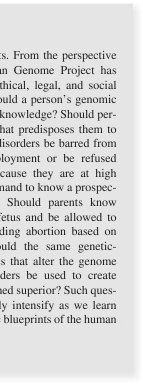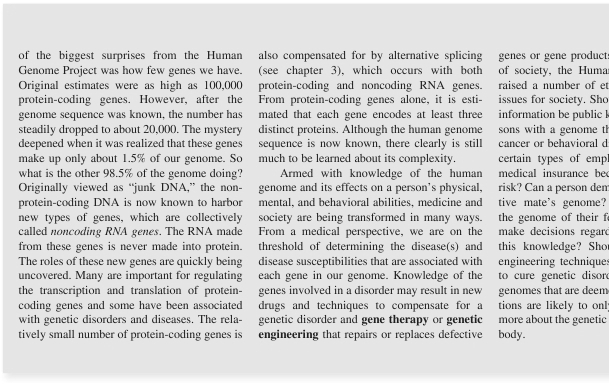CHAPTER 29 Development, Growth, Aging, and Genetics

1119

products.ethical,ShouldemploymentbecausedemandregardingShoulddisordersdeemed
Genetic disorders involve either a single gene or an entirechromosome, as in the case of aneuploidy. Recall that a mutationis a change in a gene that usually involves a change in the numberor kinds of nucleotides composing the DNA (see chapter 2). Muta-tions are known to occur by chance (randomly without knowncause), but they can also be caused by chemicals, radiation, andviruses. Anything that causes mutations is called a
mutagen
(m ū ′t ă -jen). In most cases, the specific cause of a mutation cannotbe determined. Once a mutation has occurred, however, the abnor-mal trait can be passed from one generation to the next.Mutations can vary in the amount of DNA that is affected.In some cases, a single nucleotide change in the gene can leadto changes in the function of the protein. A mutation involv-ing a single nucleotide change is called a
point mutation
. Inother cases, mutations can change the sequence or number ofnucleotides. This type of mutation involves changes in chromo-some structure and therefore are called
structural mutations
.Structural mutations can result from deletions, the loss of partof a chromosome; duplications, the addition of a copied sectionof a chromosome; translocations, in which part of one chromo-some becomes attached to another chromosome; and inversions,in which the DNA sequence of a section of a chromosome isreversed.Some large-scale mutations may result from changes in actualchromosome numbers. Segregation errors that occur during meio-sis result in changes in the chromosome number in the gametes.As the chromosomes separate during meiosis, the two membersof a homologous pair may not separate as they normally do. As aresult, one of the daughter cells receives both chromosomes, andthe other daughter cell receives none. The failure of chromosomesto separate during meiosis is called
nondisjunction.
When the
gametes are fertilized, the resulting zygote has either 47 chromo-somes or 45 chromosomes, rather than the normal 46, a conditioncalled
aneuploidy
(an′ ū -ploy-d ē ). Aneuploidies include monoso-mies, in which a chromosome is missing, and trisomies, in whichan extra chromosome is present. Aneuploidies are usually lethaland are one reason for a high rate of early embryo loss.
Downsyndrome,
or
trisomy 21
, is a type of aneuploidy in which threechromosomes 21 are present. A
syndrome
(s ĭ n′dr ō m) is a set ofsigns and symptoms occurring together as the result of a singlecause, such as a single mutation or one extra chromosome (a tri-somy). Down syndrome is an aneuploidy that is not always lethal.However, individuals with this genetic disorder exhibit physicaland mental developmental problems, as well as an increased prob-ability of developing certain cancers. These individuals also havea shortened life span.
Predict 11
Mr. and Mrs. Smith, both 40 years of age, are healthy with no knowngenetic conditions. Their newborn child has Down syndrome (trisomy 21).Explain the events that caused this condition.

ASSESS
YOUR PROGRESS
51.
What is meiosis? How does it differ from mitosis? What isthe end result of meiosis?
52.
What is a carrier?
53.
What is a mutagen? Describe a point mutation, structuralmutation, and nondisjunction.
54.
What causes the genetic disorder Down syndrome?